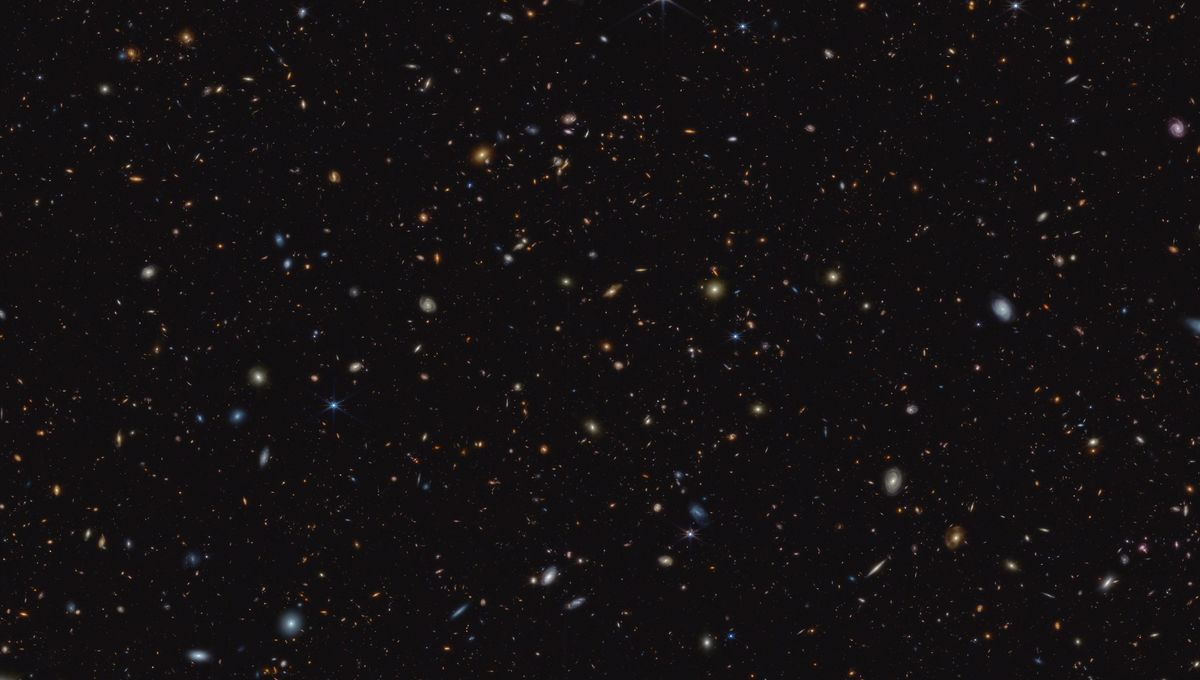
JWST has been spoiling us with amazing views of the cosmos, from distant galaxies to nearby planets. But even being used to the amazement can’t really prepare us for this latest photo. Its latest deep field is a glittering scene of more than 45,000 galaxies, adding to a total of stars bordering on the ridiculous.
Just look at it. Even on the clearest moonless night in a place with a perfectly dark sky, you might see a few thousand stars. Here, we are seeing 20 times more galaxies than the stars our eyes can naturally see, each galaxy a cosmic island of billions of stars. Galaxies that are so far from us that it allows us to learn what the universe was like just a few hundred million years after the Big Bang.
That’s a neat trick of the finite speed of light in the universe. Looking at stuff far away is looking into the past – a past we know still too little about. The deep field is part of JADES, the JWST Advanced Deep Extragalactic Survey, one of the largest programs with the observatory so far. They are trying to understand the first 1 billion years of the universe.
Hydrogen gas was spread about like a fog blocking light from freely passing through. It is only intense light that ripped those hydrogen atoms apart separating their nuclei from their electrons and making the universe transparent, a process called reionization. The cause of this intense light could be supermassive black holes or it could be hot, massive stars shining in ultraviolet light. The JADES program is looking for detailed answers by measuring star formation in these distant objects.
“Almost every single galaxy that we are finding shows these unusually strong emission line signatures indicating intense recent star formation. These early galaxies were very good at creating hot, massive stars,” said Ryan Endsley, from the University of Texas at Austin, in a statement.
But this is not the only goal of JADES. They are pushing the envelope on how far back this telescope can look, finding galaxies already assembled less than 400 million years after the beginning of the cosmos.
“With JADES, we want to answer a lot of questions, like: How did the earliest galaxies assemble themselves? How fast did they form stars? Why do some galaxies stop forming stars?” Marcia Rieke of the University of Arizona, co-lead of the JADES program, said.
Another interesting result from JADES is a galaxy from 700 million years after the Big Bang, featuring a galaxy that is 100 times less massive and more compact than our own but looking already very mature. In particular, the observations show that the younger stars are on the outskirts of it: the galaxy is growing from the inside out.
“I was surprised to find such a compact galaxy this early in the universe,” explained Dr Sandro Tacchella from Cambridge’s Cavendish Laboratory and Kavli Institute for Cosmology. “I’m excited that the telescope works so well, allowing us to do such detailed measurements of galaxies that are so distant.”
The area seen in this image is known as GOODS-South and it has been studied by Hubble and other telescopes. JWST adds another level of detail to those previous observations.
“Previously, the earliest galaxies we could see just looked like little smudges. And yet those smudges represent millions or even billions of stars at the beginning of the universe,” explained Kevin Hainline of the University of Arizona in Tucson. “Now, we can see that some of them are actually extended objects with visible structure. We can see groupings of stars being born only a few hundred million years after the beginning of time.”
The results are reported at the 242nd meeting of the American Astronomical Society.
Source Link: New JWST Deep Field Is Sparkling With Star Formation In Odd Galaxies